Microwave Irradiation: Alternative Heating Process for the Synthesis of Biologically Applicable Chromones, Quinolones, and Their Precursors
Abstract
:1. Introduction
2. Microwave-Assisted Aldol Condensation in the Synthesis of Chalcones
3. Microwave-Induced Baker-Venkataraman Rearrangement for the Synthesis of Chromones
4. Microwave-Assisted Knoevenagel Condensation in 3-Styryl-4H-chromen-4-ones Synthesis
5. Microwave-Induced Heck Reaction towards the Synthesis of (E)-3-styrylflavones and (E)-3-styrylquinolin-4(1H)-ones
6. Diels–Alder Reactions Using 4H-chromen-4-ones and Quinolin-4(1H)-ones as Dienes
7. Tandem Reactions towards the Synthesis of Oxygen Polycyclic Compounds
8. Miscellaneous Reactions
9. Conclusions
Author Contributions
Funding
Institutional Review Board Statement
Informed Consent Statement
Data Availability Statement
Acknowledgments
Conflicts of Interest
References
- Beach, E.S.; Cui, Z.; Anastas, P.T. Green Chemistry: A design framework for sustainability. Energy Environ. Sci. 2009, 2, 1038–1049. [Google Scholar] [CrossRef]
- Mulvihill, M.J.; Beach, E.S.; Zimmerman, J.B.; Anastas, P.T. Green Chemistry and Green Engineering: A Framework for Sustainable Technology Development. Annu. Rev. Environ. Resour. 2011, 36, 271–293. [Google Scholar] [CrossRef] [Green Version]
- Varma, R.S. Solvent-free organic syntheses using supported reagents and microwave irradiation. Green Chem. 1999, 1, 43–55. [Google Scholar] [CrossRef]
- Lidström, P.; Tierney, J.; Wathey, B.; Westman, J. Microwave assisted organic synthesis—A review. Tetrahedron 2001, 57, 9225–9283. [Google Scholar] [CrossRef]
- Kappe, C.O. Controlled microwave heating in modern organic synthesis. Angew. Chem. Int. Ed. 2004, 43, 6250–6284. [Google Scholar] [CrossRef]
- de la Hoz, A.; Díaz-Ortiz, Á.; Moreno, A. Microwaves in organic synthesis. Thermal and non-thermal microwave effects. Chem. Soc. Rev. 2005, 34, 164–178. [Google Scholar] [CrossRef]
- Díaz-Ortiz, Á.; Prieto, P.; de la Hoz, A. A Critical Overview on the Effect of Microwave Irradiation in Organic Synthesis. Chem. Rec. 2019, 19, 85–97. [Google Scholar] [CrossRef] [Green Version]
- Horikoshi, S.; Watanabe, T.; Narita, A.; Suzuki, Y.; Serpone, N. The electromagnetic wave energy effect(s) in microwave–assisted organic syntheses (MAOS). Sci. Rep. 2018, 8, 5151. [Google Scholar] [CrossRef]
- Farah, M.; Pelle, L. Microwave-assisted Chemistry in Drug Discovery. Curr. Topics Med. Chem. 2004, 4, 773–792. [Google Scholar]
- Reis, J.; Gaspar, A.; Milhazes, N.; Borges, F. Chromone as a Privileged Scaffold in Drug Discovery: Recent Advances. J. Med. Chem. 2017, 60, 7941–7957. [Google Scholar] [CrossRef]
- Dhiman, P.; Arora, N.; Thanikachalam, P.V.; Monga, V. Recent advances in the synthetic and medicinal perspective of quinolones: A review. Bioorg. Chem. 2019, 92, 103291. [Google Scholar] [CrossRef]
- Li, J.J. Aldol condensation. In Name Reactions: A Collection of Detailed Mechanisms and Synthetic Applications; Springer: Berlin/Heidelberg, Germany, 2009; pp. 3–5. [Google Scholar]
- Nielsen, A.T.; Houlihan, W.J. The Aldol Condensation. In Organic Reactions; John Wiley & Sons: Hoboken, NJ, USA, 2011; pp. 1–438. [Google Scholar]
- Rozmer, Z.; Perjési, P. Naturally occurring chalcones and their biological activities. Phytochem. Rev. 2016, 15, 87–120. [Google Scholar] [CrossRef]
- Silva, A.M.S.; Tavares, H.R.; Barros, A.I.N.R.A.; Cavaleiro, J.A.S. NMR and Structural and Conformational Features of 2′-Hydroxychalcones and Flavones. Spectrosc. Lett. 1997, 30, 1655–1667. [Google Scholar] [CrossRef]
- Barros, A.I.R.N.A.; Silva, A.M.S. Efficient Synthesis of Nitroflavones by Cyclodehydrogenation of 2′-Hydroxychalcones and by the Baker-Venkataraman Method. Monatsh. Chem. 2006, 137, 1505–1528. [Google Scholar] [CrossRef]
- Rocha, D.H.A.; Vaz, P.A.A.M.; Pinto, D.C.G.A.; Silva, A.M.S. Synthesis Chalones and Their Isomerization into Flavanones and Azaflavanones. Methods Protoc. 2019, 2, 70. [Google Scholar] [CrossRef] [Green Version]
- Silva, C.F.M.; Batista, V.F.; Pinto, D.C.G.A.; Silva, A.M.S. Challenges with chromone as a privileged scaffold in drug discovery. Expert Opin. Drug Discov. 2018, 13, 795–798. [Google Scholar] [CrossRef] [Green Version]
- Baker, W. Molecular rearrangement of some o-acyloxyacetophenones and the mechanism of the production of 3-acylchromones. J. Chem. Soc. 1933, 322, 1381–1389. [Google Scholar] [CrossRef]
- Pinto, D.C.G.A.; Silva, A.M.S.; Cavaleiro, J.A.S. A convenient synthesis of new (E)-5-hydroxy-2-styrylchromones by modifications of the Baker–Venkataraman method. New J. Chem. 2000, 24, 85–92. [Google Scholar] [CrossRef]
- Pinto, D.C.G.A.; Silva, A.M.S.; Almeida, L.M.P.M.; Cavaleiro, J.A.S.; Elguero, J. 3-Aroyl-5-hydroxyflavones: Synthesis and Transformation into Aroylpyrazoles. Eur. J. Org. Chem. 2002, 2002, 3807–3815. [Google Scholar] [CrossRef]
- Pinto, D.C.G.A.; Silva, A.M.S.; Cavaleiro, J.A.S. Baker-Venkataraman Rearrangement Under Microwave Irradiation: A New Strategy for the Synthesis of 3-Aroyl-5-hydroxyflavones. Synlett 2007, 2007, 1897–1900. [Google Scholar]
- Pinto, D.C.G.A.; Seca, A.M.L.; Leal, S.B.; Silva, A.M.S.; Cavaleiro, J.A.S. A Novel Short-Step Synthesis of New Xanthenedione Derivatives from the Cyclization of 3-Cinnamoyl-2-styrylchromones. Synlett 2011, 22, 2005–2008. [Google Scholar] [CrossRef]
- Almeida, A.I.S.; Silva, V.L.M.; Silva, A.M.S.; Pinto, D.C.G.A.; Cavaleiro, J.A.S. Syntheses of Novel (E)-N-Methyl-2-styryl-4-quinolones. Synlett 2008, 2008, 2593–2596. [Google Scholar]
- Knoevenagel, E. Obituary. Angew. Chem. 1922, 35, 29–30. [Google Scholar]
- Knoevenagel, E. Condensation von Malonsäure mit aromatischen Aldehyden durch Ammoniak und Amine. Ber. Dtsch. Chem. Ges. 1898, 31, 2596–2619. [Google Scholar] [CrossRef] [Green Version]
- Knoevenagel, E. Ueber Condensationsproducte von Acetylaceton mit Aldehyden. Ber. Dtsch. Chem. Ges. 1903, 36, 2136–2180. [Google Scholar] [CrossRef]
- Heravi, M.M.; Janati, F.; Zadsirjan, V. Applications of Knoevenagel condensation reaction in the total synthesis of natural products. Monatsh. Chem. 2020, 151, 439–482. [Google Scholar] [CrossRef]
- Silva, V.L.M.; Silva, A.M.S.; Pinto, D.C.G.A.; Cavaleiro, J.A.S.; Patonay, T. Condensation of Chromone-3-carboxaldehyde with Phenylacetic Acids: An Efficient Synthesis of (E)-3-Styrylchromones. Synlett 2004, 2004, 2717–2720. [Google Scholar] [CrossRef]
- Silva, V.L.M.; Silva, A.M.S.; Pinto, D.C.G.A.; Cavaleiro, J.A.S.; Vasas, A.; Patonay, T. Syntheses of (E)- and (Z)-3-styrylchromones. Monatsh. Chem. 2008, 139, 1307. [Google Scholar] [CrossRef]
- Patonay, T.; Kiss-Szikszai, A.; Silva, V.M.L.; Silva, A.M.S.; Pinto, D.C.G.A.; Cavaleiro, J.A.S.; Jekő, J. Microwave-Induced Synthesis and Regio- and Stereoselective Epoxidation of 3-Styrylchromones. Eur. J. Org. Chem. 2008, 1937–1946. [Google Scholar] [CrossRef]
- Heck, R.F.; Nolley, J.P. Palladium-catalyzed vinylic hydrogen substitution reactions with aryl, benzyl, and styryl halides. J. Org. Chem. 1972, 37, 2320–2322. [Google Scholar] [CrossRef]
- Heck, R.F. Palladium-Catalyzed Vinylation of Organic Halides. In Organic Reactions; John Wiley & Sons: Hoboken, NJ, USA, 1982; pp. 345–390. [Google Scholar]
- Mc Cartney, D.; Guiry, P.J. The asymmetric Heck and related reactions. Chem. Soc. Rev. 2011, 40, 5122–5150. [Google Scholar] [CrossRef]
- Dounay, A.B.; Overman, L.E. The Asymmetric Intramolecular Heck Reaction in Natural Product Total Synthesis. Chem. Rev. 2003, 103, 2945–2964. [Google Scholar] [CrossRef]
- Reznikov, A.N.; Ashatkina, M.A.; Klimochkin, Y.N. Recent developments in asymmetric Heck type cyclization reactions for constructions of complex molecules. Org. Biomol. Chem. 2021, 19, 5673–5701. [Google Scholar] [CrossRef] [PubMed]
- Singh, B.K.; Kaval, N.; Tomar, S.; Eycken, E.V.D.; Parmar, V.S. Transition Metal-Catalyzed Carbon−Carbon Bond Formation Suzuki, Heck, and Sonogashira Reactions Using Microwave and Microtechnology. Org. Process. Res. Dev. 2008, 12, 468–474. [Google Scholar] [CrossRef]
- Rocha, D.H.A.; Pinto, D.C.G.A.; Silva, A.M.S.; Patonay, T.; Cavaleiro, J.A.S. A New Synthesis of 5-Arylbenzo[c]xanthones from Photoinduced Electrocyclisation and Oxidation of (E)-3-Styrylflavones. Synlett 2012, 2012, 559–564. [Google Scholar]
- Rocha, D.H.A.; Pinto, D.C.G.A.; Silva, A.M.S. Synthesis and cyclisation studies of (E)-2-aryl-1-methyl-3-styrylquinolin-4(1H)-ones. Tetrahedron 2015, 71, 7717–7721. [Google Scholar] [CrossRef]
- Diels, O.; Alder, K. Synthesen in der hydroaromatischen Reihe. Liebigs Ann. Chem. 1928, 460, 98–122. [Google Scholar] [CrossRef]
- Berson, J.A. Discoveries missed, discoveries made: Creativity, influence, and fame in chemistry. Tetrahedron 1992, 48, 3–17. [Google Scholar] [CrossRef]
- Nicolaou, K.C.; Snyder, S.A.; Montagnon, T.; Vassilikogiannakis, G. The Diels–Alder Reaction in Total Synthesis. Angew. Chem. Int. Ed. 2002, 41, 1668–1698. [Google Scholar] [CrossRef]
- Tasdelen, M.A. Diels–Alder “click” reactions: Recent applications in polymer and material science. Polym. Chem. 2011, 2, 2133–2145. [Google Scholar] [CrossRef]
- Gregoritza, M.; Brandl, F.P. The Diels–Alder reaction: A powerful tool for the design of drug delivery systems and biomaterials. Eur. J. Pharm. Biopharm. 2015, 97, 438–453. [Google Scholar] [CrossRef]
- Pinto, D.C.G.A.; Silva, A.M.S.; Almeida, L.M.P.M.; Carrillo, J.R.; Díaz-Ortiz, A.; de la Hoz, A.; Cavaleiro, J.A.S. First Diels-Alder Reactions of 3-Styrylchromones under Microwave Irradiation. Synlett 2003, 2003, 1415–1418. [Google Scholar] [CrossRef]
- Sandulache, A.; Silva, A.M.S.; Pinto, D.C.G.A.; Almeida, L.M.P.M.; Cavaleiro, J.A.S. Wittig reactions of chromone-3-carboxaldehydes with benzylidenetriphenyl phosphoranes: A new synthesis of 3-styrylchromones. New J. Chem. 2003, 27, 1592–1598. [Google Scholar] [CrossRef]
- Pinto, D.C.G.A.; Silva, A.M.S.; Brito, C.M.; Sandulache, A.; Carrillo, J.R.; Prieto, P.; Díaz-Ortiz, A.; de la Hoz, A.; Cavaleiro, J.A.S. Reactivity of 3-Styrylchromones as Dienes in Diels–Alder Reactions under Microwave Irradiation: A New Synthesis of Xanthones. Eur. J. Org. Chem. 2005, 2005, 2973–2986. [Google Scholar] [CrossRef]
- Albuquerque, H.M.T.; Santos, C.M.M.; Cavaleiro, J.A.S.; Silva, A.M.S. (E)-2-(4-Arylbut-1-en-3-yn-1-yl)chromones as Synthons for the Synthesis of Xanthone-1,2,3-triazole Dyads. Eur. J. Org. Chem. 2015, 2015, 4732–4743. [Google Scholar] [CrossRef] [Green Version]
- Albuquerque, H.M.T.; Santos, C.M.M.; Lima, C.F.R.A.C.; Santos, L.M.N.B.F.; Cavaleiro, J.A.S.; Silva, A.M.S. 2-[(1E,3E)-4-Arylbuta-1,3-dien-1-yl]-4H-chromen-4-ones as Dienes in Diels–Alder Reactions—Experimental and Computational Studies. Eur. J. Org. Chem. 2017, 2017, 87–101. [Google Scholar] [CrossRef] [Green Version]
- Almeida, A.I.S.; Silva, V.L.M.; Silva, A.M.S.; Pinto, D.C.G.A.; Cavaleiro, J.A.S. Diels-Alder Reactions of (E)-2-Styrylquinolin-4(1H)-ones with N-Methylmaleimide: New Syntheses of Acridin-9(10H)-ones. Synlett 2012, 23, 889–892. [Google Scholar] [CrossRef]
- Silva, V.L.M.; Silva, A.M.S.; Pinto, D.C.G.A.; Cavaleiro, J.A.S.; Elguero, J. Novel (E)- and (Z)-3(5)-(2-hydroxyphenyl)-4-styrylpyrazoles from (E)- and (Z)-3-styrylchromones: The unexpected case of (E)-3(5)-(2-hydroxyphenyl)-4-(4-nitrostyryl)pyrazoles. Tetrahedron Lett. 2007, 48, 3859–3862. [Google Scholar] [CrossRef]
- Silva, V.L.M.; Silva, A.M.S.; Pinto, D.C.G.A.; Cavaleiro, J.A.S.; Elguero, J. Synthesis of (E)- and (Z)-3(5)-(2-hydroxyphenyl)-4-styrylpyrazoles. Monatsh. Chem. 2008, 140, 87. [Google Scholar] [CrossRef]
- Silva, V.L.M.; Silva, A.M.S.; Pinto, D.C.G.A.; Cavaleiro, J.A.S. Efficient Microwave-Assisted Synthesis of Tetrahydroindazoles and their Oxidation to Indazoles. Synlett 2006, 2006, 1369–1373. [Google Scholar] [CrossRef]
- Silva, V.L.M.; Silva, A.M.S.; Pinto, D.C.G.A.; Elguero, J.; Cavaleiro, J.A.S. Synthesis of New 1H-Indazoles through Diels–Alder Transformations of 4-Styrylpyrazoles under Microwave Irradiation Conditions. Eur. J. Org. Chem. 2009, 4468–4479. [Google Scholar] [CrossRef]
- Albuquerque, H.M.T.; Santos, C.M.M.; Cavaleiro, J.A.S.; Silva, A.M.S. First intramolecular Diels–Alder reactions using chromone derivatives: Synthesis of chromeno[3,4-b]xanthones and 2-(benzo[c]chromenyl)chromones. New J. Chem. 2018, 42, 4251–4260. [Google Scholar] [CrossRef] [Green Version]
- Malafaia, D.; Oliveira, A.; Fernandes, P.A.; Ramos, M.J.; Albuquerque, H.M.T.; Silva, A.M.S. Chromeno[3,4-b]xanthones as First-in-Class AChE and Aβ Aggregation Dual-Inhibitors. Int. J. Mol. Sci. 2021, 22, 4145. [Google Scholar] [CrossRef]
- Sousa, J.L.C.; Silva, A.M.S. Microwave-Assisted Tandem Reactions towards a New Synthesis of Cyclohepta[b]chromene-9,11-diones. Synlett 2017, 28, 316–322. [Google Scholar]
- Albuquerque, H.M.T.; Santos, C.M.M.; Silva, A.M.S. Cholesterol-Based Compounds: Recent Advances in Synthesis and Applications. Molecules 2019, 24, 116. [Google Scholar] [CrossRef] [Green Version]
- Nes, W.D. Biosynthesis of Cholesterol and Other Sterols. Chem. Rev. 2011, 111, 6423–6451. [Google Scholar] [CrossRef] [PubMed]
- Cerqueira, N.M.; Oliveira, E.F.; Gesto, D.S.; Santos-Martins, D.; Moreira, C.; Moorthy, H.N.; Ramos, M.J.; Fernandes, P.A. Cholesterol Biosynthesis: A Mechanistic Overview. Biochemistry 2016, 55, 5483–5506. [Google Scholar] [CrossRef] [PubMed]
- Albuquerque, H.M.T.; Francisco, T.; Malafaia, D.; Cavaleiro, J.A.S.; Silva, A.M.S. A-ring functionalization of cholestane with highly substituted pyrans and 2-aminoisophthalonitriles. Arkivoc 2021, vii, 353–364. [Google Scholar] [CrossRef]
- Patoilo, D.T.; Silva, A.M.S.; Pinto, D.C.G.A.; Tomé, A.C.; Cavaleiro, J.A.S. Synthesis of 5-Hydroxy-2-(naphth-2-yl)chromone derivatives. J. Heterocycl. Chem. 2007, 44, 1345–1350. [Google Scholar] [CrossRef]
- Seca, A.M.L.; Leal, S.B.; Pinto, D.C.G.A.; Barreto, M.C.; Silva, A.M.S. Xanthenedione Derivatives, New Promising Antioxidant and Acetylcholinesterase Inhibitor Agents. Molecules 2014, 19, 8317–8333. [Google Scholar] [CrossRef] [Green Version]
- Silva, A.M.S.; Silva, A.M.G.; Tomé, A.C.; Cavaleiro, J.A.S. New Syntheses of Flavones from Diels–Alder Reactions of 2-Styrylchromones with ortho-Benzoquinodimethanes. Eur. J. Org. Chem. 1999, 1999, 135–139. [Google Scholar] [CrossRef]





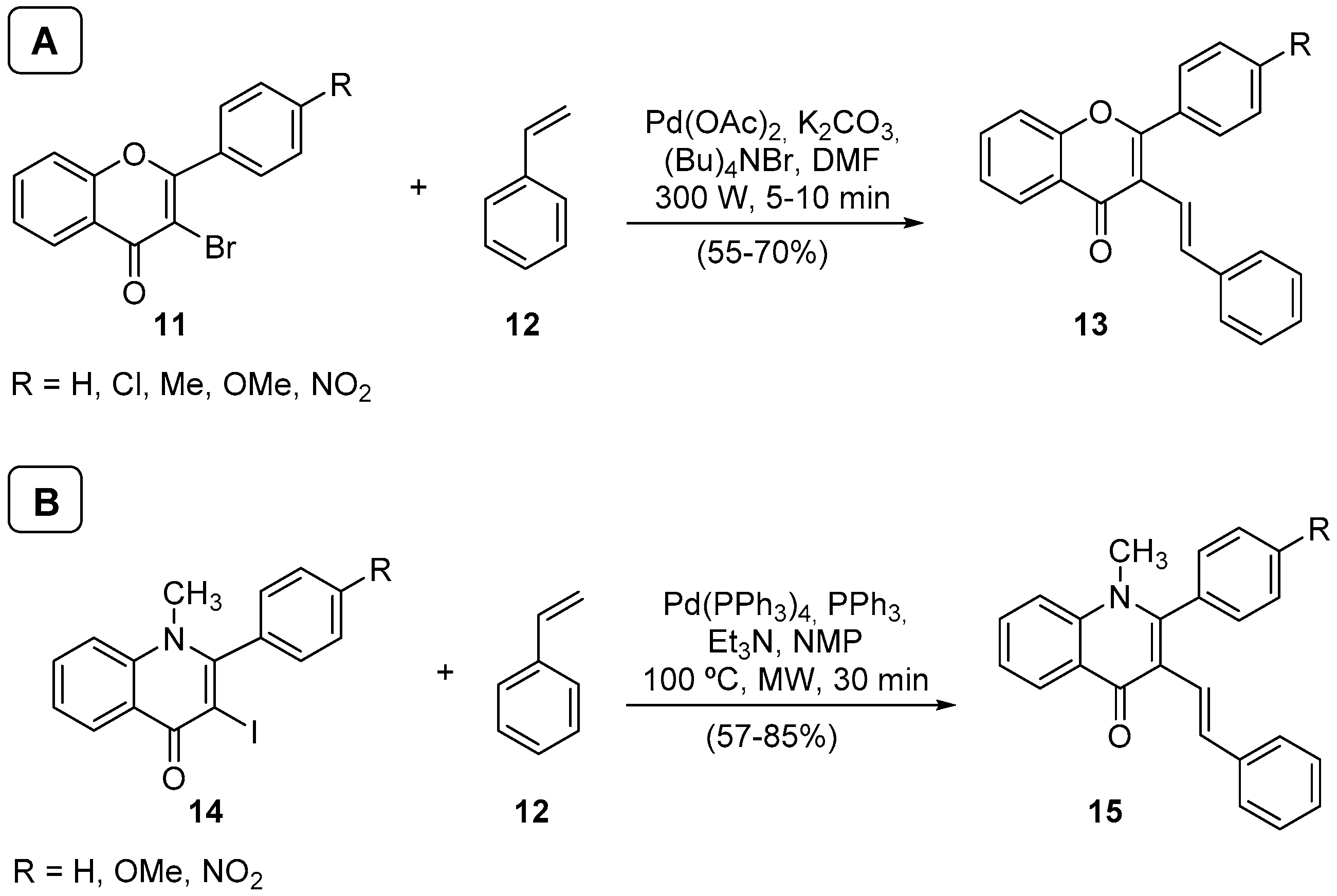
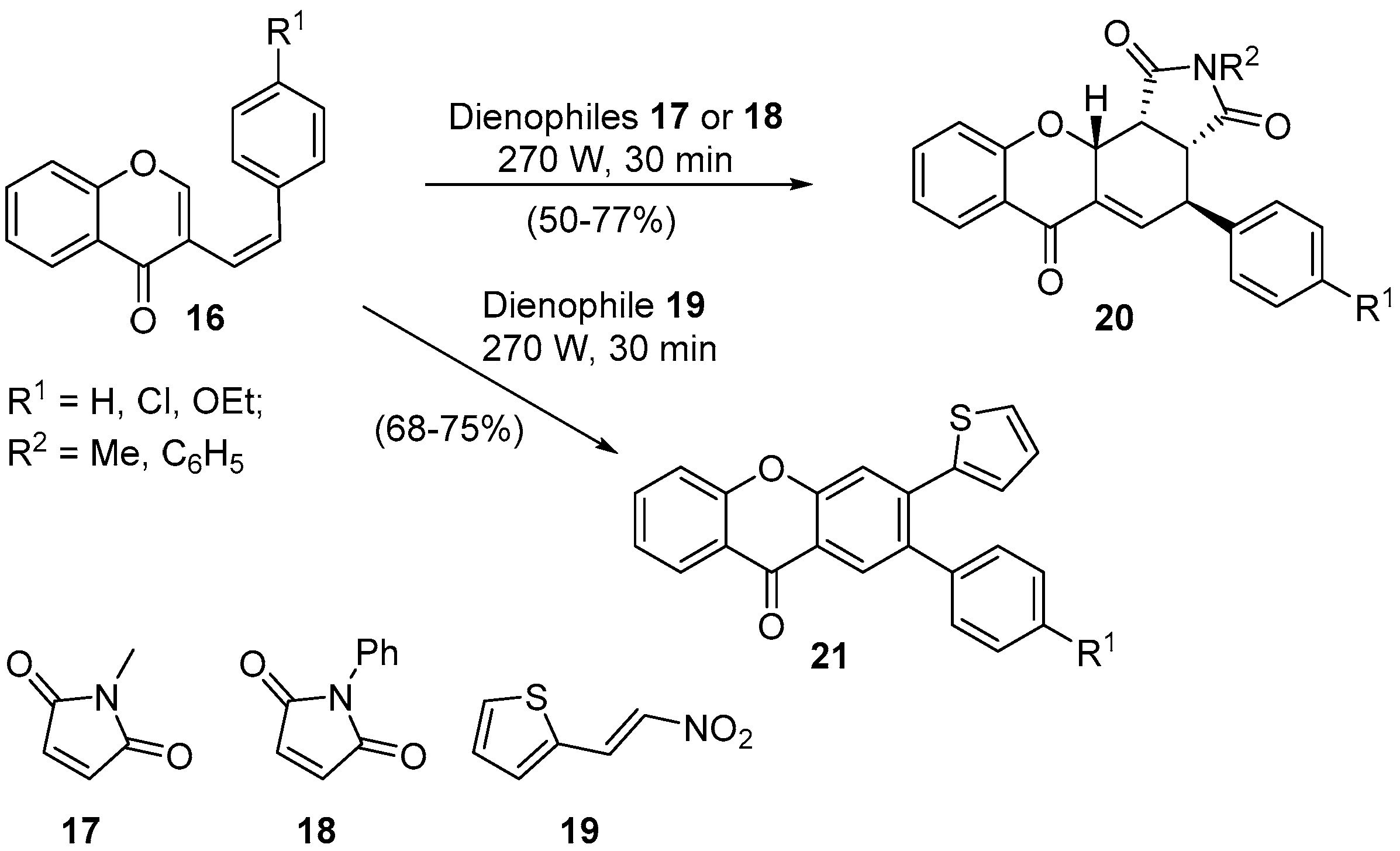

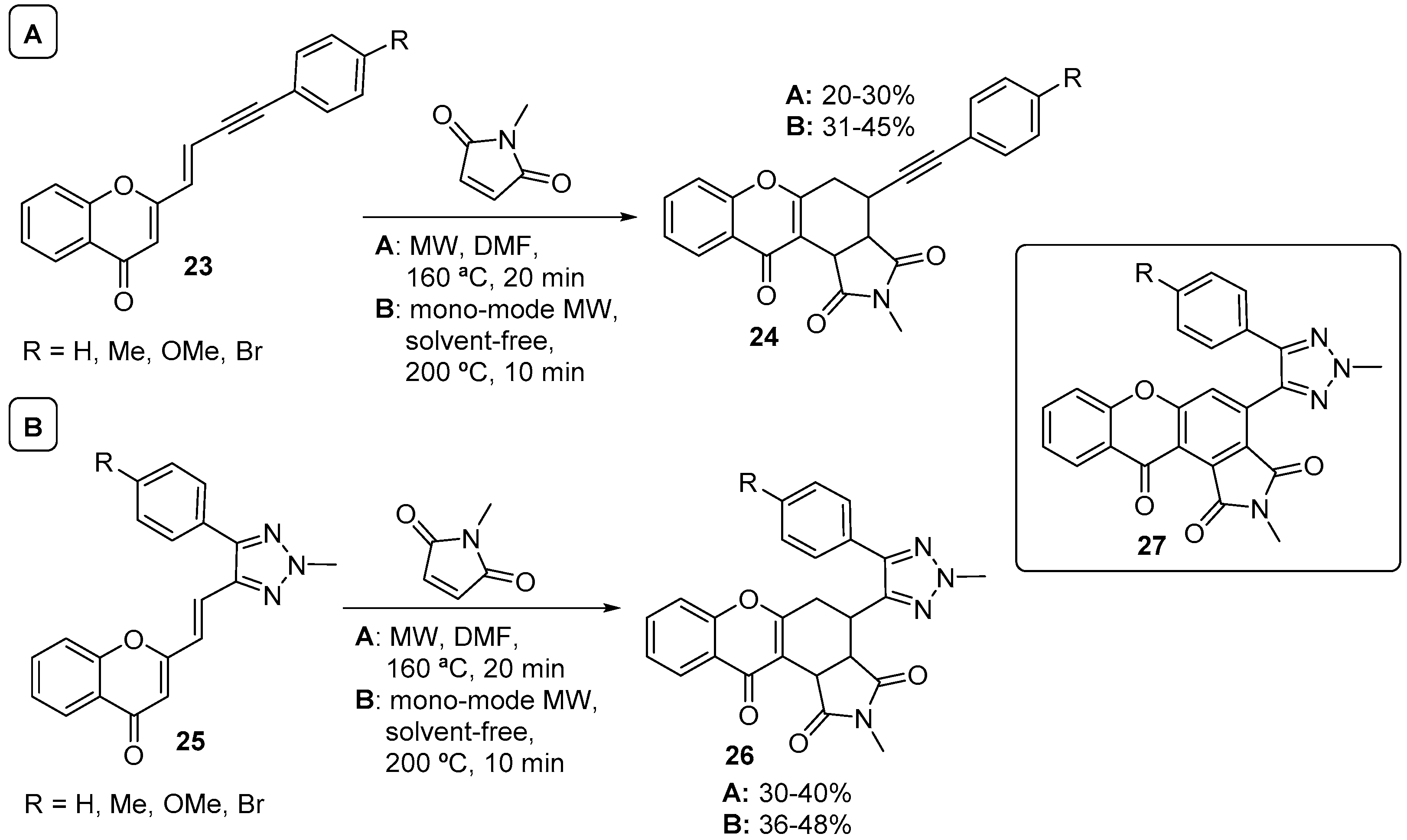

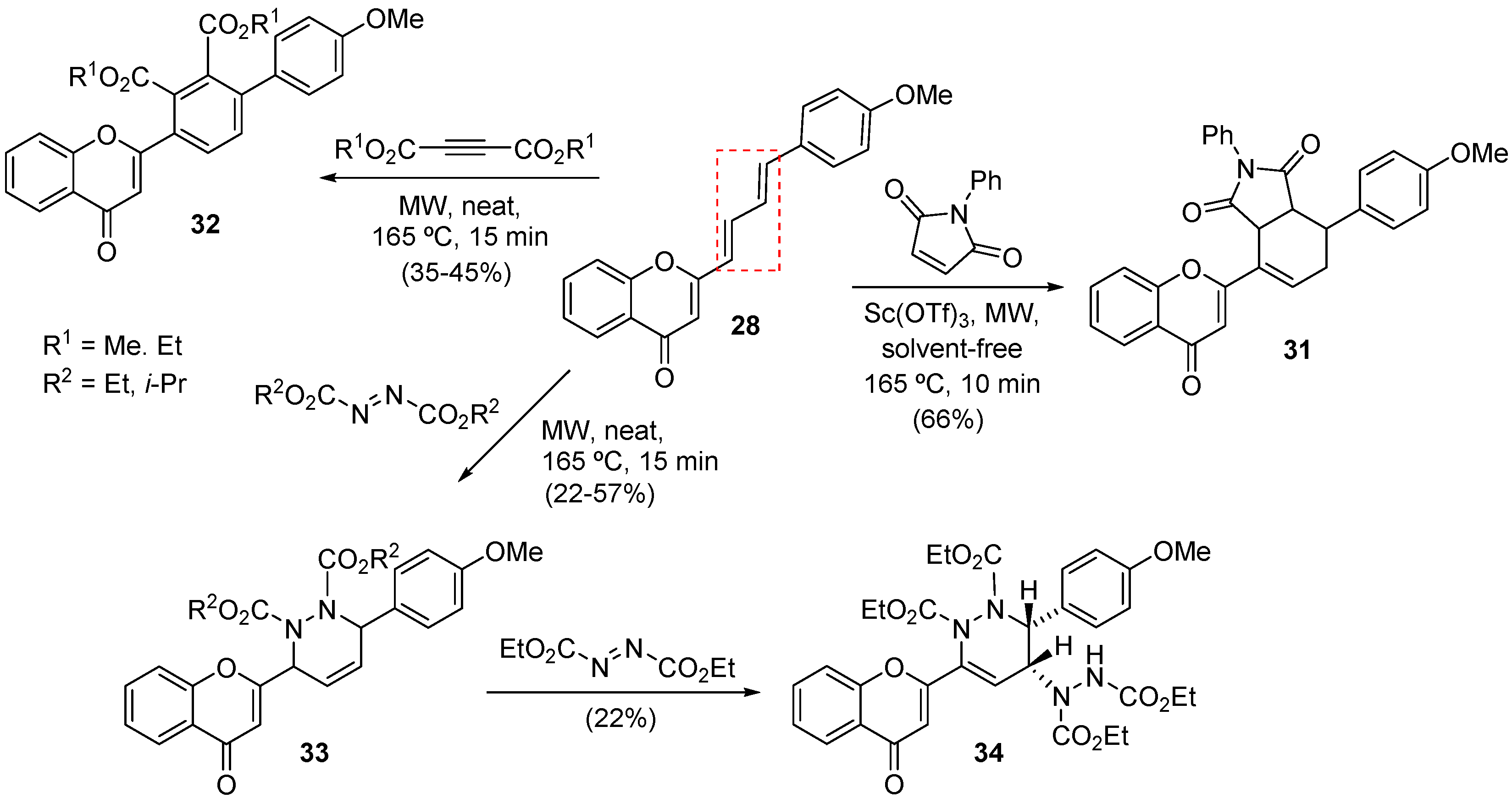

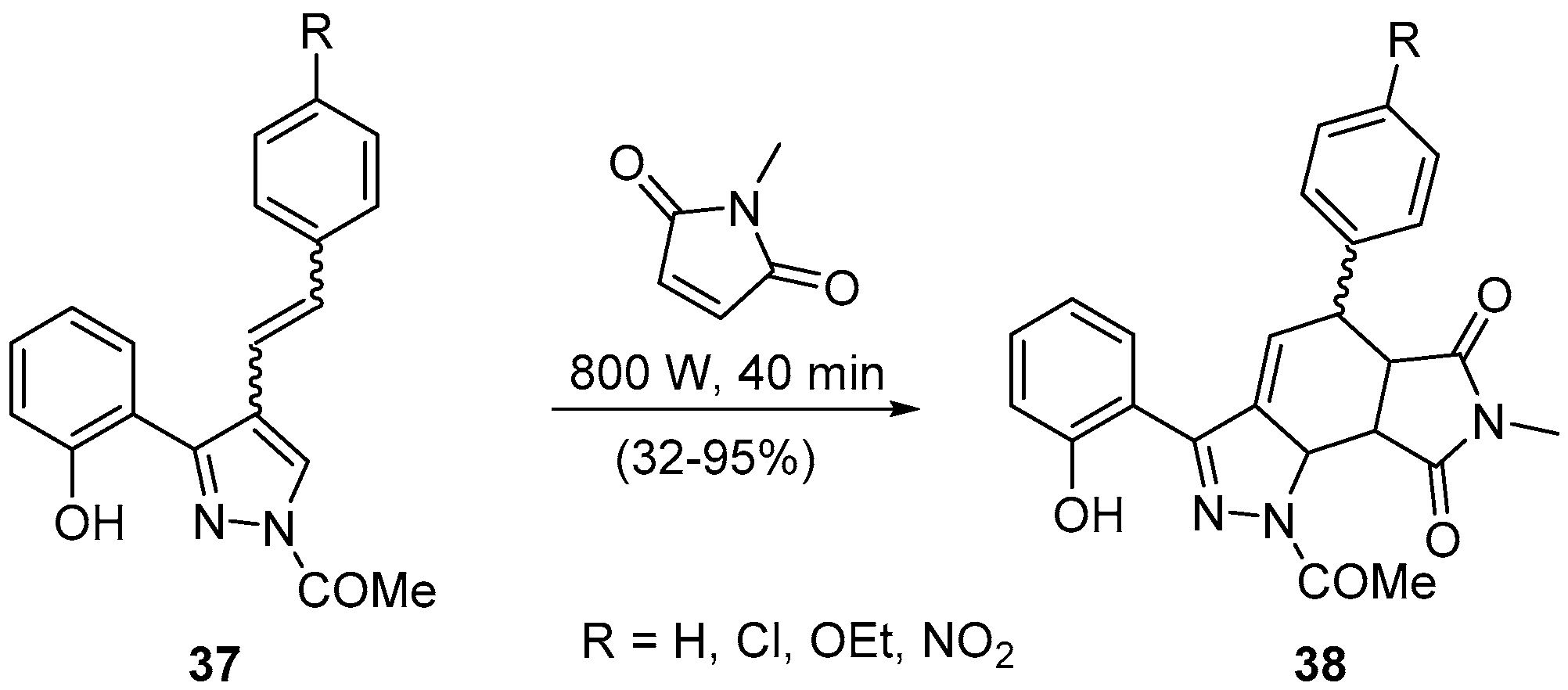
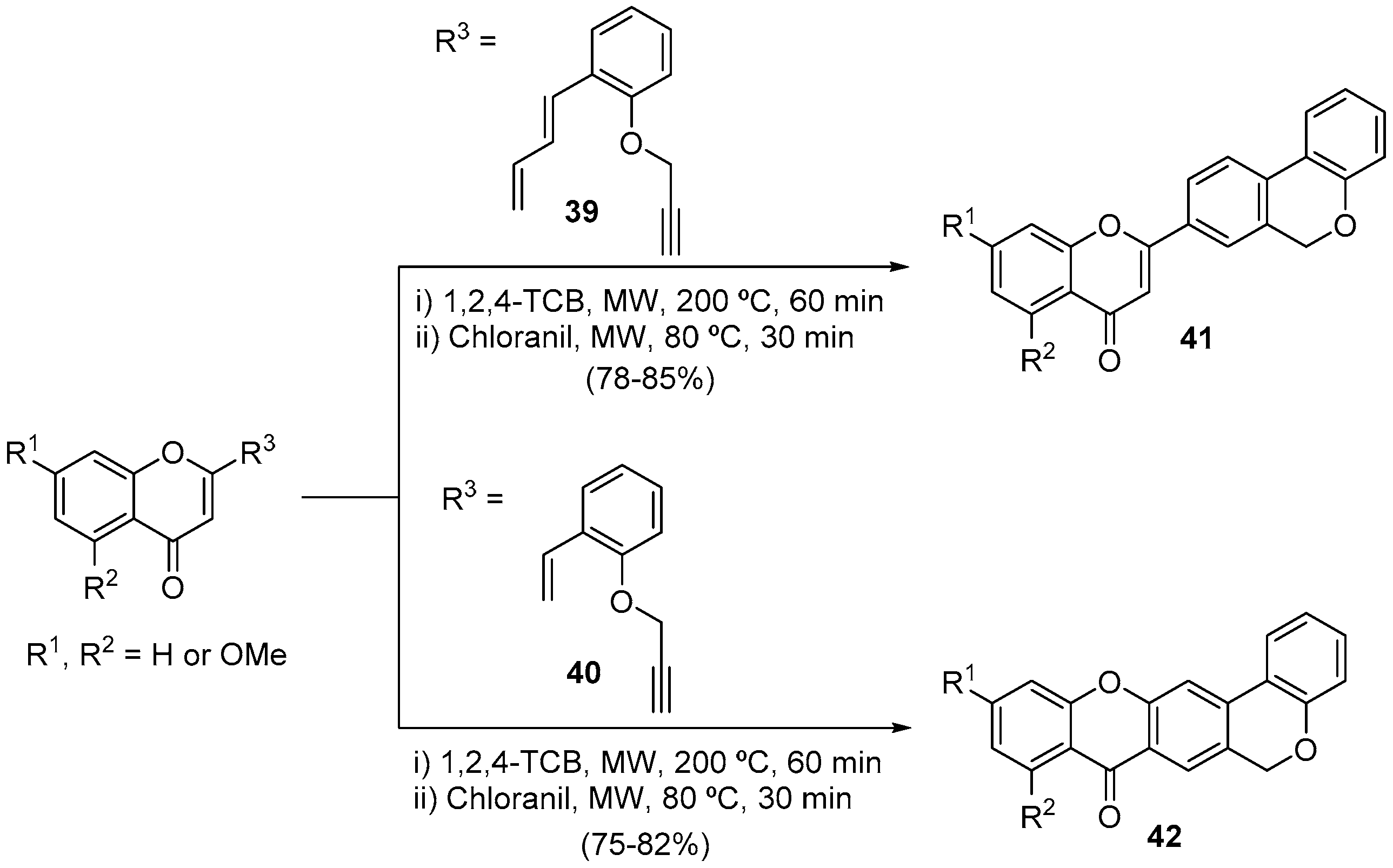
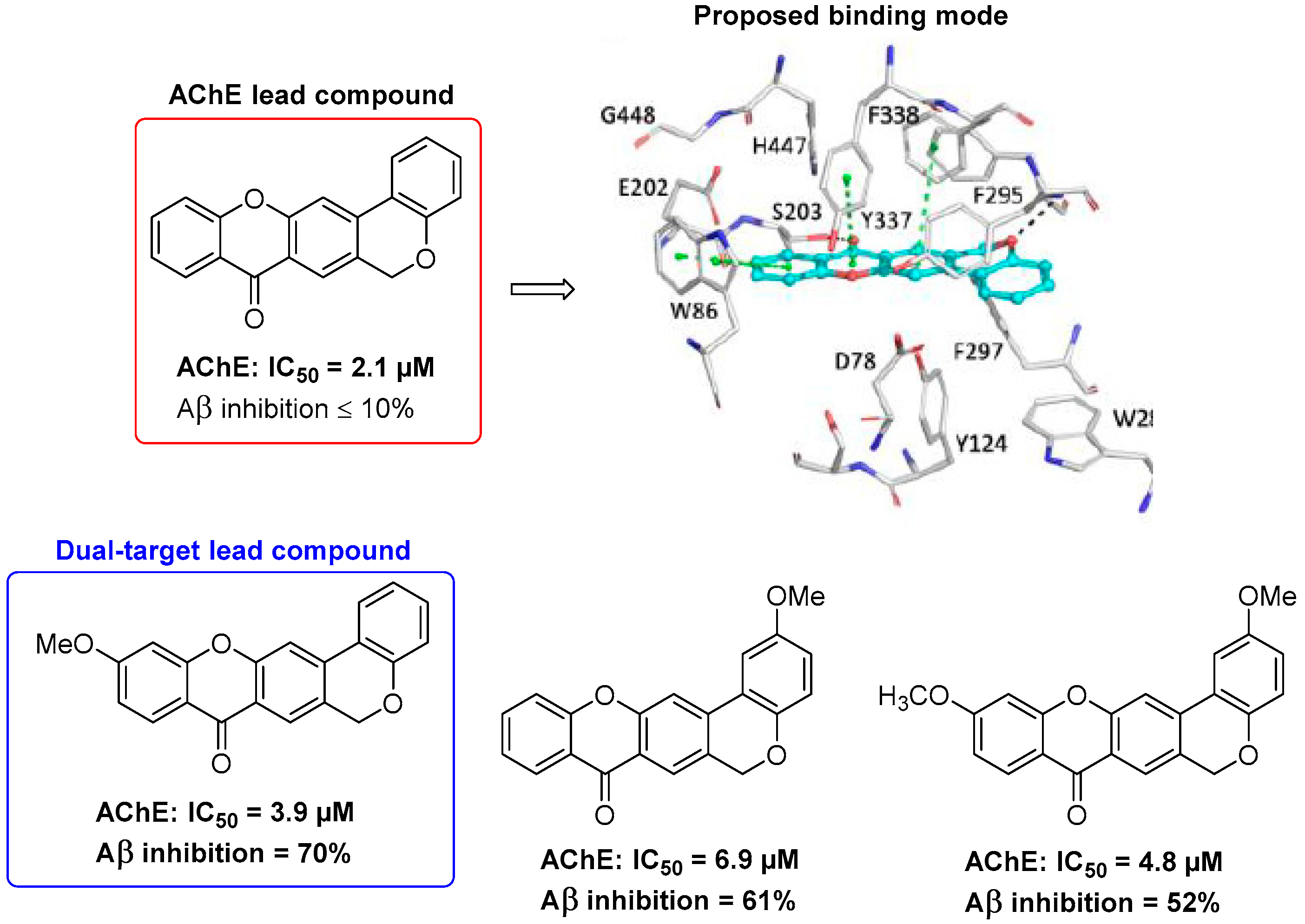
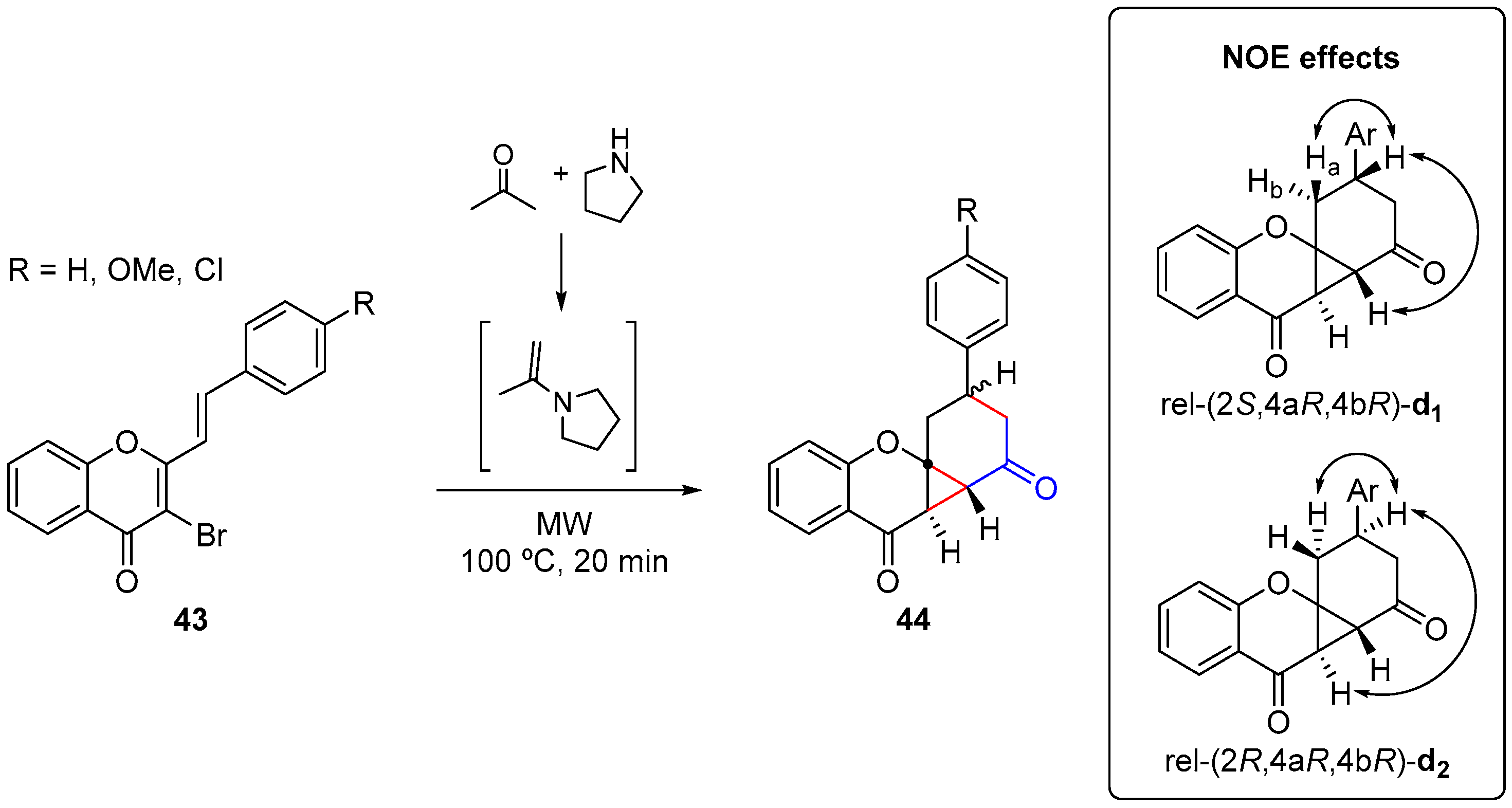
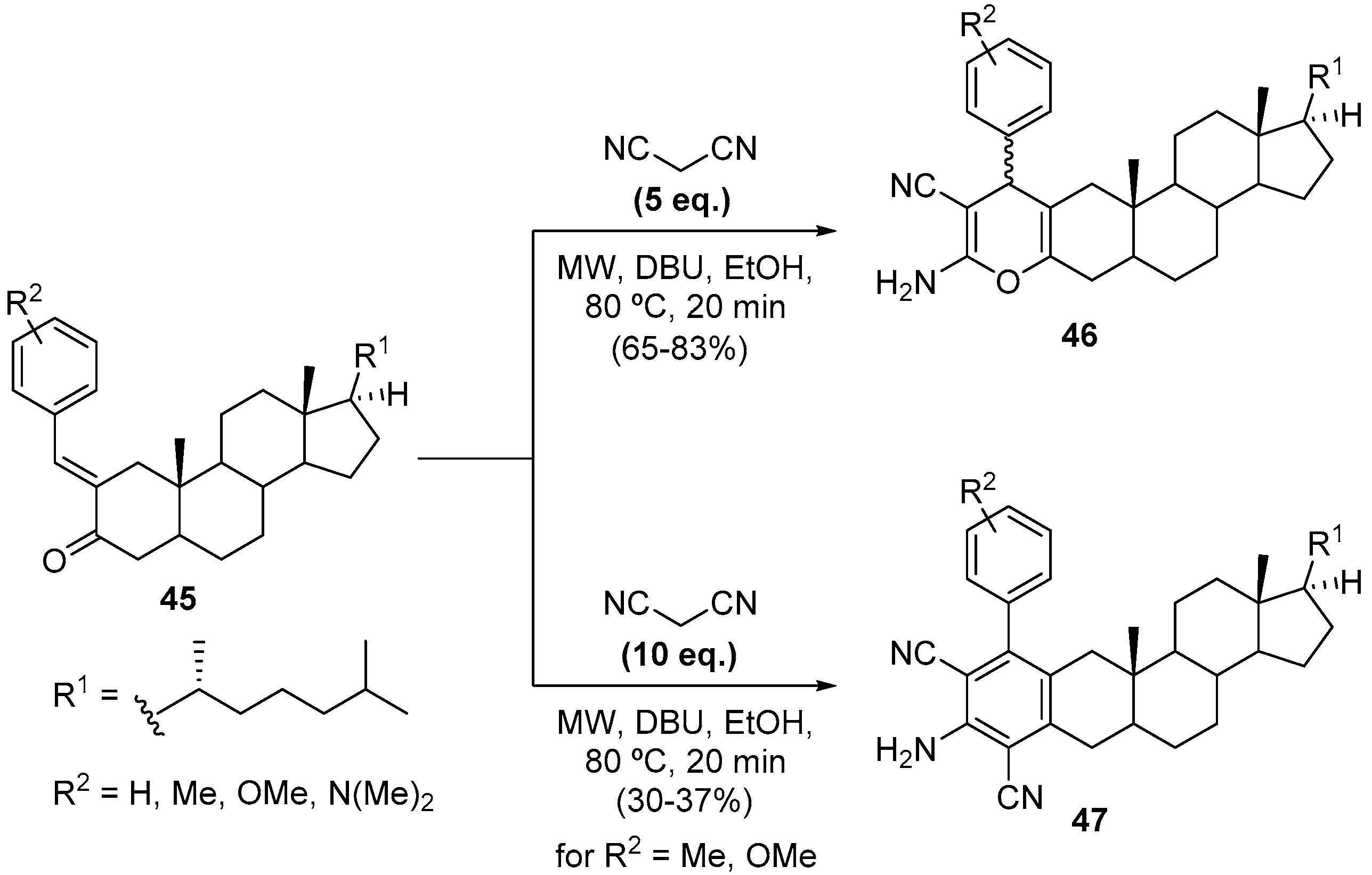



Publisher’s Note: MDPI stays neutral with regard to jurisdictional claims in published maps and institutional affiliations. |
© 2021 by the authors. Licensee MDPI, Basel, Switzerland. This article is an open access article distributed under the terms and conditions of the Creative Commons Attribution (CC BY) license (https://creativecommons.org/licenses/by/4.0/).
Share and Cite
Albuquerque, H.M.T.; Pinto, D.C.G.A.; Silva, A.M.S. Microwave Irradiation: Alternative Heating Process for the Synthesis of Biologically Applicable Chromones, Quinolones, and Their Precursors. Molecules 2021, 26, 6293. https://doi.org/10.3390/molecules26206293
Albuquerque HMT, Pinto DCGA, Silva AMS. Microwave Irradiation: Alternative Heating Process for the Synthesis of Biologically Applicable Chromones, Quinolones, and Their Precursors. Molecules. 2021; 26(20):6293. https://doi.org/10.3390/molecules26206293
Chicago/Turabian StyleAlbuquerque, Hélio M. T., Diana C. G. A. Pinto, and Artur M. S. Silva. 2021. "Microwave Irradiation: Alternative Heating Process for the Synthesis of Biologically Applicable Chromones, Quinolones, and Their Precursors" Molecules 26, no. 20: 6293. https://doi.org/10.3390/molecules26206293
APA StyleAlbuquerque, H. M. T., Pinto, D. C. G. A., & Silva, A. M. S. (2021). Microwave Irradiation: Alternative Heating Process for the Synthesis of Biologically Applicable Chromones, Quinolones, and Their Precursors. Molecules, 26(20), 6293. https://doi.org/10.3390/molecules26206293








